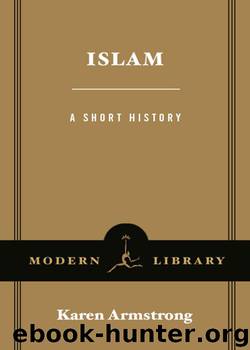Islam by Karen Armstrong

Author:Karen Armstrong
Language: eng
Format: epub
Tags: Nonfiction
ISBN: 9780307431318
Publisher: Random House Publishing Group
Published: 2007-12-17T16:00:00+00:00
4
ISLAM TRIUMPHANT
IMPERIAL ISLAM (1500-1700)
The discovery and exploitation of gunpowder led to the development of a military technology that gave rulers more power over their subjects than before. They could control greater areas more effectively, provided that they also developed an efficient, rationalized administration. The military state, which had been a feature of Islamic politics since the decline of Abbasid power, could now come into its own. In Europe also, monarchs were beginning to build large centralized states and absolute monarchies, with a more streamlined government machinery. Three major Islamic empires were created in the late fifteenth and early sixteenth centuries: the Safavid Empire in Iran, the Moghul Empire in India and the Ottoman Empire in Anatolia, Syria, North Africa and Arabia. Other impressive polities also appeared. A large Muslim state was formed in Uzbekhistan in the Syr-Oxus basin; another state with Shii tendencies was established in Morocco, and even though Muslims were at this time in competition with Chinese, Japanese, Hindu and Buddhist traders for the control of the Malayan archipelago, the Muslims came out on top in the sixteenth century.
It was, therefore, a period of triumph. The three major empires all seemed to turn their backs on the egalitarian traditions of Islam, and set up absolute monarchies, however. Almost every facet of public life was run with systematic and bureaucratic precision and the empires developed a sophisticated administration. They were all influenced by the Mongol idea of the army state, but involved civilians in their imperial policies, so that the dynasties won more grass-roots support. But these empires were very different from the old Abbasid state in one important respect. The Abbasid caliphs and their court had never been truly Islamic institutions; they had not been subject to the laws of the Shariah and had evolved their own worldly ethos. The new empires, however, all had a strongly Islamic orientation, promoted by the rulers themselves. In Safavid Iran, Shiism became the state religion; Falsafah and Sufism were dominant influences on Moghul policy; while the Ottoman Empire was run entirely on Shariah lines.
But the old problems remained. However pious an absolute monarch might seem to be, such autocracy was fundamentally opposed to the spirit of the Quran. Most of the people still lived in poverty, and suffered the injustices that were endemic to agrarian society. There were also new difficulties. Moghul India and Anatolia, the heartland of the Ottoman Empire, were both places where Muslims were relative newcomers. Both would have to learn to relate to their non-Muslim subjects, who formed the majority of the population. The establishment of a Shii Empire caused a new and decisive rift between Sunnis and Shiis, leading to an intolerance and an aggressive sectarianism that was unprecedented in the Islamic world but which was similar to the bitter conflict between Catholics and Protestants that erupted at the same time in Europe. There was also the challenge of Europe itself, which had hitherto been a backward region and of little interest to Muslims. Europe, however,
Download
This site does not store any files on its server. We only index and link to content provided by other sites. Please contact the content providers to delete copyright contents if any and email us, we'll remove relevant links or contents immediately.
| Buddhism | Christianity |
| Ethnic & Tribal | General |
| Hinduism | Islam |
| Judaism | New Age, Mythology & Occult |
| Religion, Politics & State |
Cecilia; Or, Memoirs of an Heiress — Volume 1 by Fanny Burney(31341)
Cecilia; Or, Memoirs of an Heiress — Volume 3 by Fanny Burney(30938)
Cecilia; Or, Memoirs of an Heiress — Volume 2 by Fanny Burney(30894)
The Secret History by Donna Tartt(16643)
Sapiens: A Brief History of Humankind by Yuval Noah Harari(13067)
Leonardo da Vinci by Walter Isaacson(11912)
The Radium Girls by Kate Moore(10914)
Sapiens by Yuval Noah Harari(4546)
The Wind in My Hair by Masih Alinejad(4427)
How Democracies Die by Steven Levitsky & Daniel Ziblatt(4407)
Homo Deus: A Brief History of Tomorrow by Yuval Noah Harari(4287)
Endurance: Shackleton's Incredible Voyage by Alfred Lansing(3852)
The Silk Roads by Peter Frankopan(3769)
Man's Search for Meaning by Viktor Frankl(3644)
Millionaire: The Philanderer, Gambler, and Duelist Who Invented Modern Finance by Janet Gleeson(3574)
The Rape of Nanking by Iris Chang(3522)
Hitler in Los Angeles by Steven J. Ross(3443)
The Motorcycle Diaries by Ernesto Che Guevara(3340)
Joan of Arc by Mary Gordon(3262)
